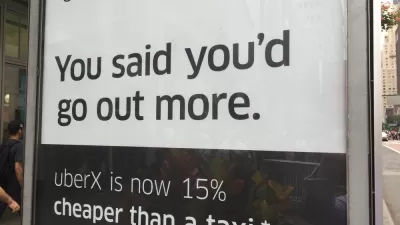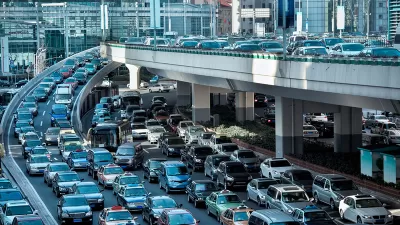A ride-hailing company that lost $5.2 billion in one quarter wants to launch a flying taxi service. According to this op-ed, cities should concentrate on expanding existing public transit systems instead of wasting time and money on pipe dreams.

Matt Caywood, CEO and co-founder of TransitScreen, writes an opinion piece to critique the idea of flying Ubers, taking to the skies to save us all from congestion.
The idea of flying Ubers is "disconnected from reality," argues Caywood. "The price estimate is nearly $6 per mile, making a 20-mile trip from the Upper East Side to JFK cost around $120, compared to the current $7.75 combo of the subway and AirTrain. Can someone make money providing helicopter service to the rich? Sure. Is it the mass market a public company like Uber needs? No."
The news of Uber Elevate, also called Uber Air, first hit the Planetizen newswire in May 2018. The technology that would fly these Ubers is called VTOL, signifying Vertical Takeoff and Landing. The company is already making plans to build its first skyport facility in Frisco, Texas. Caywood has a bone to pick with people who are making the case that flying Ubers might somehow be a sustainable mode of transportation.
However, left unsaid is how people would arrive at the skyport in order to take the taxis. The first skyport is slated to be built at Frisco Station outside Dallas, a greenfield mixed-use development with zero access to public transportation. That means the only people who could use it either already live there or have to drive — or, in what is likely the planned scenario, take an Uber. The environmental impact as compared to a subway carrying hundreds of people running all the way to the airport, then, is still greater.
Caywood also notes that inability of a flying taxi to accommodate may users at once: "Like hyperloop, in any realistic scenario, it only adds a tiny percentage of capacity to the network, but not enough to make a difference."
FULL STORY: Op-Ed: What Flying Ubers Mean For the Future

Trump Administration Could Effectively End Housing Voucher Program
Federal officials are eyeing major cuts to the Section 8 program that helps millions of low-income households pay rent.

Planetizen Federal Action Tracker
A weekly monitor of how Trump’s orders and actions are impacting planners and planning in America.

Ken Jennings Launches Transit Web Series
The Jeopardy champ wants you to ride public transit.

Rebuilding Smarter: How LA County Is Guiding Fire-Ravaged Communities Toward Resilience
Los Angeles County is leading a coordinated effort to help fire-impacted communities rebuild with resilience by providing recovery resources, promoting fire-wise design, and aligning reconstruction with broader sustainability and climate goals.

When Borders Blur: Regional Collaboration in Action
As regional challenges outgrow city boundaries, “When Borders Blur” explores how cross-jurisdictional collaboration can drive smarter, more resilient urban planning, sharing real-world lessons from thriving partnerships across North America.

Philadelphia Is Expanding its Network of Roundabouts
Roundabouts are widely shown to decrease traffic speed, reduce congestion, and improve efficiency.
Urban Design for Planners 1: Software Tools
This six-course series explores essential urban design concepts using open source software and equips planners with the tools they need to participate fully in the urban design process.
Planning for Universal Design
Learn the tools for implementing Universal Design in planning regulations.
Ada County Highway District
Clanton & Associates, Inc.
Jessamine County Fiscal Court
Institute for Housing and Urban Development Studies (IHS)
City of Grandview
Harvard GSD Executive Education
Toledo-Lucas County Plan Commissions
Salt Lake City
NYU Wagner Graduate School of Public Service





























